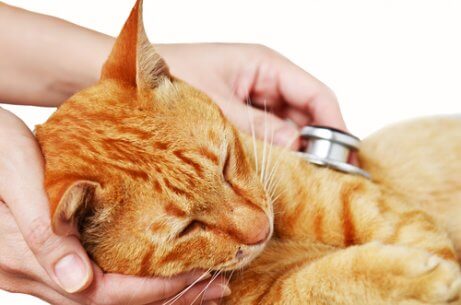AIDS in Cats: What You Need to Know


Written and verified by the lawyer Francisco María García
Despite their strong and independent personalities, cats are also sensitive animals that are susceptible to numerous diseases. Among them, AIDS in cats is one of the most frequent and worrying diseases to affect the feline population.
Fortunately, today there is an effective treatment for feline AIDS that can increase the life expectancy of infected cats. However, prevention is the best way to preserve the health of your pet. Next, we’ll take a look at the symptoms, forms of infection, and ways to prevent AIDS in cats.
Feline Immunodeficiency Virus (FIV)
First of all, we want to clarify that FIV only affects cats and can’t be transmitted to humans. This is a type of virus that affects and destroys T lymphocytes in the feline immune system.
Keep in mind that HIV, which causes human AIDS, is a totally different virus. However, it does act in a similar way to FIV.
By destroying lymphocytes, FIV makes the feline organism more vulnerable to numerous diseases. When the animal has weakened natural defenses, it’s easier to contract infections or other diseases.

When AIDS in cats isn’t treated properly, these secondary diseases can cause death.
FIV in cats is a chronic disease that doesn’t yet have a known cure. As the disease progresses, the animal experiences a progressive deterioration of its immune system. However, with responsible and appropriate treatment, you can give a good quality of life to an infected feline.
Forms of contagion
Feline AIDS is transmitted through direct contact with the blood or saliva of an infected cat. This contact usually occurs during fights between cats. Because of this, cats that live on the street are more likely to become infected with this disease.
It hasn’t been proven whether FIV can be transmitted sexually. However, AIDS in cats can be transmitted congenitally. A mother can also transmit FIV to their offspring during pregnancy or delivery.
To avoid risks, we highly recommend the castration or sterilization of infected cats to control the spread of feline AIDS. It’s also essential to combat overcrowding of animals on the street. This can help prevent the spread of various contagious diseases.

Symptoms of AIDS in cats
The first symptoms of feline AIDS can appear a few months after contracting FIV. Typically, they are general symptoms, and they generally intensify as the disease evolves.
Normally, owners realize something is wrong with their cat when they have issues with recurrent infections. Suddenly, their cat starts to have repeated infections or is constantly ill.
However, some cats live for years without showing any symptoms and live a completely normal life. This is why it is so important to visit the vet periodically. A vet will do the necessary tests to check your cat’s health.
The main symptoms associated with AIDS in cats are:
- Fever
- Diarrhea
- Loss of appetite and weight loss
- Loss of shine on their coat
- Gingivitis
- Stomatitis
- Diseases and recurrent infections
- Conjunctivitis
- Fertility problems (and miscarriages in females)
- Progressive mental deterioration
The treatment of AIDS in cats
The treatment of feline AIDS is to strengthen and prevent the deterioration of the infected cat’s immune system. One key factor to improve your cat’s immune system is their intake of food. It’s important to maintain your pet in good health. In addition, there are vitamins and natural supplements that can help improve their natural defenses.

After confirming the diagnosis, a vet may also consider giving some antimicrobial or anti-inflammatory drugs. These medications will help combat or impede the progression of any underlying diseases.
It’s also essential to avoid exposing the infected cat to any conditions or situations that could put his health at risk. For example, you shouldn’t let your cat outside due to the high risk of coming into contact with diseases or getting involved in a street fight.
Along with the above, the cat must be living in a positive and safe environment. They also should receive proper care, vaccines, and food to have an excellent quality of life.
Prevention
When it comes to the health of your cat, prevention is key. To prevent AIDS in cats, you should take care of the following basic care needs:
- Complete, balanced nutrition with high-quality food
- Preventative measures throughout the life of the cat. This should also include visits to the veterinarian every six months. Also, always follow a vaccination and deworming schedule.
- Reproductive control (castration or sterilization)
- Physical activity and mental stimulation
- A positive, safe environment with optimal hygiene
- Appropriate education and socialization to avoid attempted escapes and reduce the risk of fights with other cats
All cited sources were thoroughly reviewed by our team to ensure their quality, reliability, currency, and validity. The bibliography of this article was considered reliable and of academic or scientific accuracy.
- Yamamoto, J., Sanou, M., Abbott, J., & Coleman, J. (2010). Feline Immunodeficiency Virus Model for Designing HIV/AIDS Vaccines. Current HIV Research. https://doi.org/10.2174/157016210790416361
-
Hartmann, K. (1998). Feline immunodeficiency virus infection: An overview. Veterinary Journal. https://doi.org/10.1016/S1090-0233(98)80008-7
This text is provided for informational purposes only and does not replace consultation with a professional. If in doubt, consult your specialist.